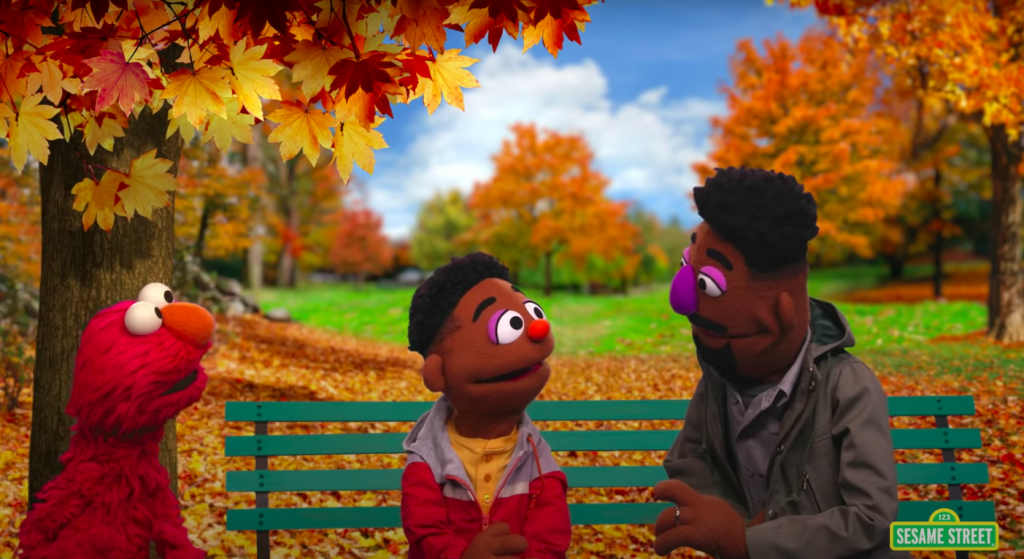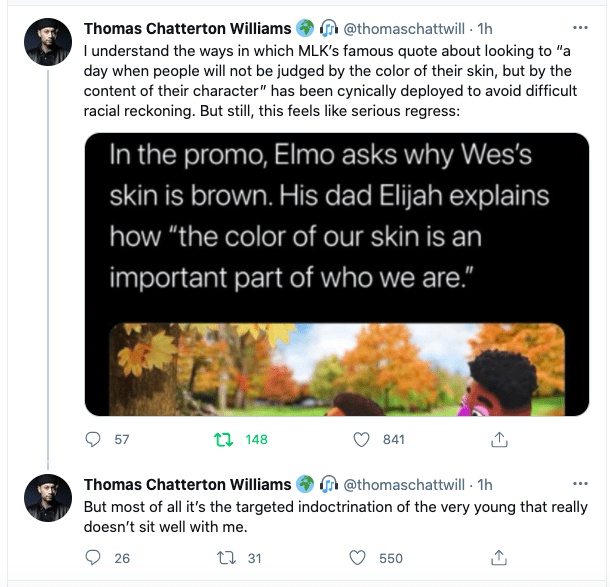Segregating ‘Sesame Street’

Sesame Street is now teaching race consciousness to little-bitties:
This makes me really sad, and I’m not kidding or exaggerating. Let me explain.
I was born in 1967. Sesame Street was born two years later. I don’t remember a time before Sesame Street. It was my window into a world beyond the rural South. In 1999, when my wife and I moved to brownstone Brooklyn, I remember thinking, “I live on Sesame Street” — this, because the streets there reminded me of what I had grown up with. Though our parish (county) was half black and half white, until I started elementary school, I lived in a world that was de facto segregated. The interesting thing to me now is that I can’t recall anybody ever teaching me about white supremacy, or why segregation was a good thing, or any of it. Maybe some white parents did teach that to their kids, but mine didn’t. Still, the ambient feeling in the air was that white people and black people are very different, and have nothing in common, so we shouldn’t mix with black people more than we strictly have to. I don’t know if any black parents taught that to their children back then, but I imagine most black kids from my town of my generation grew up with the same set of unarticulated assumptions.
How could we not have? Landmark Civil Rights legislation was less than a decade old. You cannot change a culture that took hundreds of years to make with the stroke of a pen.
As a child growing up in the early 1970s, Sesame Street was the only exposure I had to black people as people like me — this, as opposed to seeing them in the stores, and being polite, but not engaged with them. Sesame Street was where I learned how to see past color, into the humanity of black people. If you didn’t live it, it’s hard to express how totalizing the idea of color was in the South of that era. Even the most broad-minded people could not see past color — and to be fair, given that the society was governed by Jim Crow apartheid until more or less the day before I was born, you can understand how consciousness of whiteness and blackness pervaded everything. You had no choice but to see color as sorting everything about social life.
Sesame Street was not like where I lived. It was a place where color didn’t matter. Smithsonian magazine writes about how the show was designed to be like that. Excerpt:
Back when the show was less entrenched in popular culture, “Sesame Street” had its critics. A Boston Globe columnist took a swipe at the show in 1970for striving not only to teach literacy but “to inculcate the Golden Rule, the Beatitudes and the Civil Rights Act of 1964 through the television screen.” That same year, Mississippi public television concluded that its viewers were not ready for the portrayal of multiracial harmony on city streets and wouldn’t air “Sesame Street.” Parents successfully petitioned the station to bring it back and invited the show’s cast to visit Jackson, Mississippi. When the show came to town, the local police showed up in riot gear. Describing the visit in a 1988 interview, Loretta Long recalled, “Little white kids would reach out to kiss me or ‘Gordon,’ the other black character, and you could see their mothers were uneasy. But they’d loosen up, because how can you hate someone who makes your child so happy?”
Yes! Exactly! Gordon was my favorite human character on Sesame Street. I wanted him to be in my life — and in a way, he was. Even as a small child, I sensed that Sesame Street was radical. The way race was depicted on that program was not like what I saw in real life. It showed how we could live together, if we learned to see each other first as fellow humans, not as bearers of racial identity. I’m telling you, Sesame Street was the only place this vision existed for little white kids in the South (and little black kids too). It was the only place kids like me received a counternarrative to what daily life programmed into our heads about black-white relations.
I hadn’t realized how deeply the new progressive racial obsession bothered me until I saw that clip above, and realized that woke Sesame Street is now setting out to undo all the work that had been accomplished in the generations the show catechized. You know who taught my generation of children to see color? White people who longed for segregation’s return, and black people who lived in fear of white people who longed for segregation’s return.
Now kids can get that from Sesame Street. Good job, progressives; you are the most regressive force in American society today. I guess somebody has to teach the kids why it’s good to have segregated college graduations, but I’m with Thomas Chatterton Williams on this:

Subscribe for as little as $5/mo to start commenting on Rod’s blog.